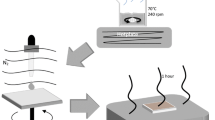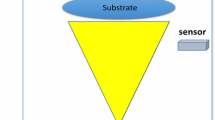Abstract
The research on perovskite-based photovoltaics is rapidly increasing in renewable energy, particularly in solar cell fields, as its efficiency has reached upto 25.7%. Although several efforts have been made to increase the lifetime and stability, several complicated processes are still required to be optimized, to achieve better structural and chemical stability. In this paper, perovskite material is prepared in different molar ratios, in combinations of lead iodide (PbI2) and methyl ammonium iodide (MAI) for better interdiffusion and structural ordering. All the measurements have been performed only using ITO as a bare substrate. The synchrotron source-based X-ray diffraction measurements together with SEM and UV–Vis spectroscopy were performed to understand the structural properties of perovskite films across the entire film thickness for three different molar ratios. The angular-dependent grazing incidence X-ray diffraction (GIXRD) under out-of-plane geometry can provide a better insight of structural properties at the film/air and film/ITO interfaces. Our GIXRD measurements summarizes that within the entire depth of the perovskite film, unreacted PbI2 small particles are not only laying at the bottom, but such unreacted PbI2 crystallites are also distributed along with the entire height of the perovskite film. This is completely new finding, which has been not reported yet. In combined, all these three (SEM, GIXRD, UV–Vis) states of the art techniques have not only provided the in-depth structural ordering within the entire height of the films but also reveals the surface morphology and varying optical properties of the film with varying the molar ratio’s too.








Similar content being viewed by others
Data availability
The authors confirm that the data supporting the findings of this study are available within the manuscript in the form of tables, graphs and images. Raw data (XRD and UV–Vis) that support the findings of this study are available from the corresponding author, upon reasonable request.
References
Best Research-Cell Efficiency Chart by NREL. https://www.nrel.gov/pv/cell-efficiency.html. Accessed 14 June 2022
A. Kheralla, N. Chetty, A review of experimental and computational attempts to remedy stability issues of perovskite solar cells. Heliyon 7, e06211 (2021). https://doi.org/10.1016/j.heliyon.2021.e06211
A. Kakekhani, R.N. Katti, A.M. Rappea, Water in hybrid perovskites: bulk MAPbI3 degradation via super-hydrous state. APL Mater. 7, 041112 (2019). https://doi.org/10.1063/1.5087290
S. Joshi, Z. Inamul Hasan, M. Pruthvi, M.P. Tulsiram, X-ray diffraction—a simplistic approach for perovskite based solar cells degradation studies. Mater. Today Proc. 35, 31–34 (2021). https://doi.org/10.1016/j.matpr.2019.05.390
J.-W. Lee, S.-G. Kim, J.-M. Yang, Y. Yang, N.-G. Park, Verification and mitigation of ion migration in perovskite solar cells. APL Mater. 7, 041111 (2019). https://doi.org/10.1063/1.5085643
H.A. Dinh, T.T.T. Nguyen, L.T. Nguyen, H.T. Nguyen, D.M. Trinh, V.A. Tran, P.T. Nguyen, Synthesis of hybrid lead iodide perovskite thin film by two-step method modified with a double dipping circle to control its crystallization and morphology to improve solar cells performance. J. Nanomater. (2021). https://doi.org/10.1155/2021/5582737
Y. Han, H. Xie, E.L. Lim, D. Bi, Review of two-step method for lead halide perovskite solar cells. Solar RRL (2022). https://doi.org/10.1002/solr.202101007
Y. Yang, J. Liang, Z. Zhang, Suppressing residual lead iodide and defects in sequential-deposited perovskite solar cell via bidentate potassium dichloroacetate ligand. ChemSusChem 15, e202102474 (2022). https://doi.org/10.1002/cssc.202102474
D. Liu, M. Chen, Z. Wei, C. Zou, Strain-free hybrid perovskite films based on a molecular buffer interface for efficient solar cells. J. Mater. Chem. A 10, 10865–10871 (2022). https://doi.org/10.1039/D2TA01649D
Y. Yao, M. Wang, Q Cai and DWei, Inhibition of PbI2-induced defects by doping MABr for high-performance perovskite solar cells. Nanoscale 14, 7203–7210 (2022). https://doi.org/10.1039/D2NR01626E
C. Roldan Carmona, P. Gratia, I. Zimmermann, G. Grancini, P. Gao, M. Gratzel, N.K. Mohammad, High efficiency methylammonium lead triiodide perovskite solar cells: the relevance of non-stoichiometric precursors. Energy Environ. Sci. 8, 3550–3556 (2015). https://doi.org/10.1039/C5EE02555A
S.M. Wang, W.W. Dong, X.D. Fang, Q.L. Zhang, S. Zhou, Z.H. Deng, R.H. Tao, J.Z. Shao, R. Xia, C. Song, L.H. Hu, J. Zhu, Credible evidence for the passivation effect of remnant PbI2 in a CH3NH3PbI3 films in improving the performance of perovskite solar cells. Nanoscale 8, 6600–6608 (2016). https://doi.org/10.1039/C5NR08344C
Y. Wang, M. Zhong, L. Chai, Effects of the concentration of PbI2 and CH3NH3I on the perovskite films and the performance of perovskite solar cells based on ZnO–TiO2 nanorod arrays. Superlattices Microstruct. 123, 189–200 (2018). https://doi.org/10.1016/j.spmi.2018.07.024
T.-L. Wu, J.-K. Tsai, Y.-Z. Song, M.-X. Chen, T.-C. Wu, Influence of molar ratio of MAI and PbI2 on the synthesis of perovskite film. Mod. Phys Lett. B 36, 2141016 (2021). https://doi.org/10.1142/S0217984921410165
R. Munir, A.D. Sheikh, M. Abdelsamie, H. Hu, L. Yu, K. Zhao, T. Kim, O.E. Tall, R. Li, D.-M. Smilgies, A. Amassian, Hybrid perovskite thin-film photovoltaics: in situ diagnostics and importance of the precursor solvate phases. Adv. Mater. 29, 1604113 (2017). https://doi.org/10.1002/adma.201604113
N.-K. Kim, Y.H. Min, S. Noh, E. Cho, G. Jeong, M. Joo, S.-W. Ahn, J.S. Lee, S. Kim, K. Ihm, H. Ahn, Y. Kang, H.-S. Lee, D. Kim, Investigation of thermally induced degradation in CH3NH3PbI3 perovskite solar cells using in situ synchrotron radiation analysis. Sci. Rep. 7, 4645 (2017). https://doi.org/10.1038/s41598-017-04690-w
F. Lehmann, A. Franz, D.M. Tobbens, S. Levcenco, T. Unold, A. Taubert, S. Schorr, The phase diagram of a mixed halide (Br, I) hybrid perovskite obtained by synchrotron X-ray diffraction. RSC Adv. 9, 11151–11159 (2019). https://doi.org/10.1039/C8RA09398A
M. Kodur, R.E. Kumar, Y. Luo, D.N. Cakan, X. Li, M. Stuckelberger, D.P. Fenning, X-ray microscopy of halide perovskites: techniques, applications, and prospects. Adv. Energy Mater. 10, 1903170 (2020). https://doi.org/10.1002/aenm.201903170
N. Alhazmi, E. Pineda, J. Rawle, J.R. Howse, A.D.F. Dunbar, Perovskite crystallization dynamics during spin-casting: an in situ wide-angle X-ray scattering study. ACS Appl. Energy Mater. 3, 6155–6164 (2020). https://doi.org/10.1021/acsaem.9b02470
Y. Yang, S. Feng, M. Li, F. Li, C. Zhang, Y. Han, L. Li, J. Yuan, L. Cao, Z. Wang, B. Sun, X. Gao, Enormously improved CH3NH3PbI3 film surface for environmentally stable planar perovskite solar cells with PCE exceeding 19.9%. Nano Energy 48, 10–19 (2018). https://doi.org/10.1016/j.nanoen.2018.03.046
J. Schlipf, P. Muller-Buschbaum, Structure of organometal halide perovskite films as determined with grazing-incidence X-ray scattering methods. Adv. Energy Mater. 7, 1700131 (2017). https://doi.org/10.1002/aenm.201700131
S. Joshi, P. Pingel, S. Grigorian, T. Panzner, U. Pietsch, D. Neher, M. Forster, U. Scherf, Bimodal temperature behavior of structure and mobility in high molecular weight P3HT thin films. Macromolecules 42(13), 4651–4660 (2009). https://doi.org/10.1021/ma900021w
B.G. Kim, W. Jang, J.S. Cho, D.H. Wang, Tailoring solubility of methylammonium lead halide with the non-stoichiometry molar ratio in perovskite solar cells: morphological and electrical relationships for the high current generation. Sol. Energy Mater. Sol. Cells 192, 24–35 (2019). https://doi.org/10.1016/j.solmat.2018.12.010
S. Joshi, S. Grigorian, U. Pietsch, P. Pingel, A. Zen, D. Neher, U. Scherf, Thickness dependence of the crystalline structure and hole mobility in thin films of low molecular weight poly(3-hexylthiophene). Macromolecules 41(18), 6800–6808 (2008). https://doi.org/10.1021/ma702802x
G. Li, J. Wu, J. Song, C. Meng, Z. Song, X. Wang, X. Liu, Y. Yang, D. Wang, Z. Lan, Excellent quinoline additive in perovskite toward to efficient and stable perovskite solar cells. J. Power Sources 481, 228857 (2021). https://doi.org/10.1016/j.jpowsour.2020.228857
X. Wang, G. Lu, M. Zhang, Y. Gao, Y. Liu, L. Zhou, Z. Lin, High performance planar structure perovskite solar cells using a solvent dripping treatment on hole transporting layer. Coatings 10(2), 127 (2020). https://doi.org/10.3390/coatings10020127
Z. Zhou, X. Zou, J. Zhu, J. Cheng, H. Ren, C. Chang, Y. Yao, D. Chen, X. Yu, G. Li, J. Wang, B. Liu, Effect of processing technique factors on structure and photophysical properties of perovskite absorption layer by using two-step spin-coating method. Crystals 10(9), 761 (2020). https://doi.org/10.3390/cryst10090761
J. Leng, T. Wang, Z.-K. Tan, Y.-J. Lee, C.-C. Chang, K. Tamada, Tuning the emission wavelength of lead halide perovskite NCs via size and shape control. ACS Omega 7(1), 565–577 (2022). https://doi.org/10.1021/acsomega.1c05001
Acknowledgements
The author is thankful to the Centre for Nanotechnology, Department of Mechanical Engineering, and Department of Industrial and Production Engineering, The National Institute of Engineering (NIE), Mysuru for providing the opportunity to carry out the work. We do acknowledge the financial support from UGC-DAE and NIE CRD, and AICTE-ADF Fellowship to one of the authors. At the same time, the authors also acknowledge the Instrument Facility received from RRCAT, Indore, and beamline support from Beamline 12 RRCAT, Indore, India.
Funding
This work was primarily supported by UGC-DAE Consortium for Scientific Research (Grant Number CSR-IC-BL-70/CRS-187/2020-21/224). The author (Siddharth Joshi) has received research support from UGC-DAE, Government of India.
Author information
Authors and Affiliations
Contributions
All authors contributed to the study conception and design. Material preparation, data collection and analysis were performed by IH and SJ. The first draft of the manuscript was written by IH and all the three authors commented and provided feedback to prepare the final draft of the above manuscript. All authors read and approved the final manuscript.
Corresponding author
Ethics declarations
Conflict of interest
The authors have neither financial or nor non-financial interests related to this manuscript.
Additional information
Publisher's Note
Springer Nature remains neutral with regard to jurisdictional claims in published maps and institutional affiliations.
Rights and permissions
About this article
Cite this article
Inamul Hasan, Z., Joshi, S. & Subbaya, K.M. Halide-based CH3NH3PbI3 hybrid perovskite thin films structural studies using synchrotron source X-ray diffraction. J Mater Sci: Mater Electron 33, 16369–16382 (2022). https://doi.org/10.1007/s10854-022-08528-8
Received:
Accepted:
Published:
Issue Date:
DOI: https://doi.org/10.1007/s10854-022-08528-8




